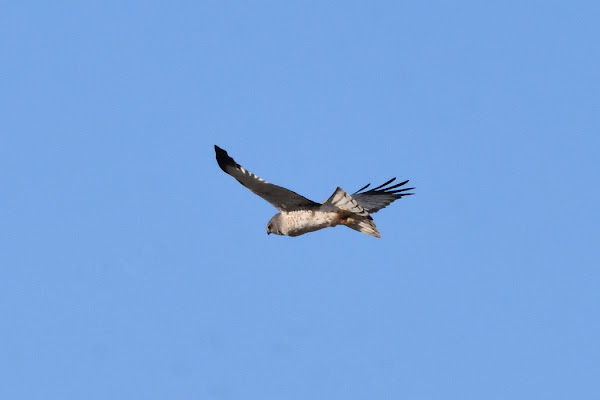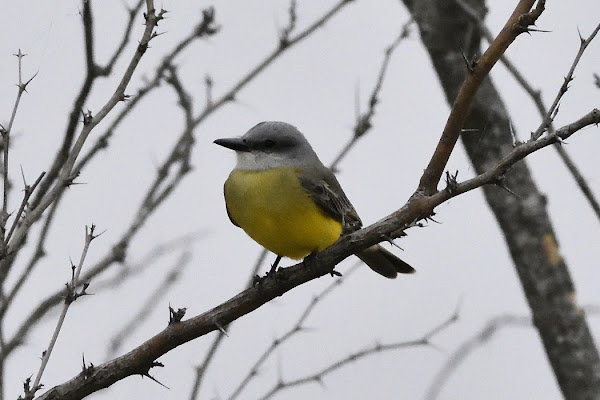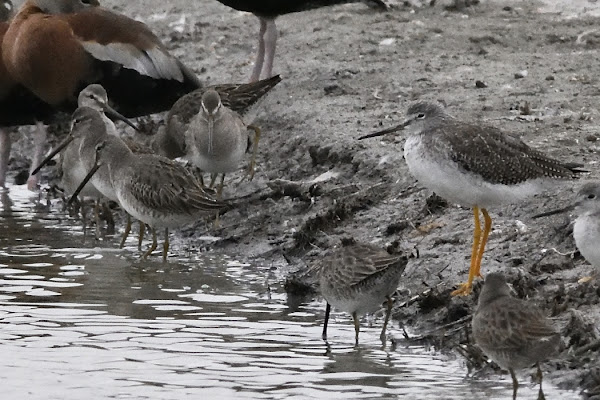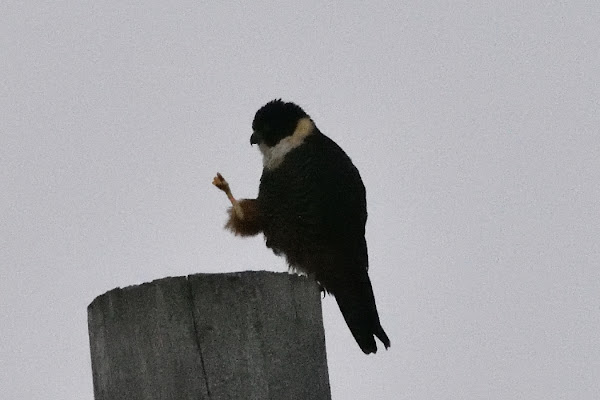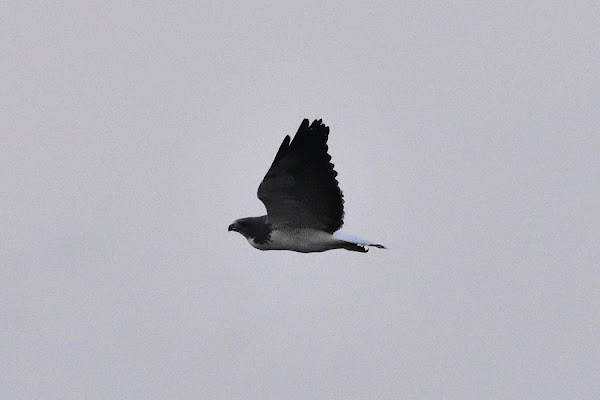I took a ride out to the Middle Creek Wildlife Management Area to look for the "Bewick's" Swan that was found there about a week ago, a first for Pennsylvania! The "Bewick's" Swan is presently classified as the Eurasian subspecies of Tundra Swan. Our subspecies is known as "Whistling" Swan. Instead of an all-black bill, about a third of the "Bewick's" bill is yellow at its base. They are rarely found in the western U.S. but are even rarer in the East where there are less than ten records. I had seen one in California years ago but had never seen one in the East.
When I got to Willow Point, there were a few birders searching for it among the close to 200 Tundra Swans. They were pretty far out on the ice-covered lake where a scope was needed to look through them, plus most of them were sleeping with their heads tucked in, so checking all of the bills was impossible. One alert birder was pretty sure that he had gotten a glimpse of 'the bird' when it briefly unutucked its head, so he directed the rest of us onto it. It took almost a half-hour before it finally became active and started preening. It 'was' the "Bewick's" Swan. I took some long-distance documentation photos of it. They are only good enough to show the yellowish patch at the base of the bill. Clicking on the photo will bring up a little larger image of each.
I also took a photo through the scope with my cell phone, which is terrible but does show the extent of yellow on the bill.
Monday, January 31, 2022
Friday, January 21, 2022
Northern Harriers on Wednesday and Friday ~ January 19 and 21, 2022
It's always a good day when you get to see a Northern Harrier. On Wednesday afternoon, I found a juvenal bird feeding on a goose carcass at the Silver Crest Road retention pond near Bath.
After getting its fill, it circled the pond and flew off to the north.
On Friday, I spotted an adult male Northern Harrier, also known as a 'Gray Ghost', fairly far out in a field along Miller Road in Lower Mount Bethel Township.
Eventually, the bird lifted off and started hunting, allowing me to get these flight photos.
Later, I got a quick look at another young Harrier near the Martins Creek PPL power plant, the third bird over three days.
After getting its fill, it circled the pond and flew off to the north.
On Friday, I spotted an adult male Northern Harrier, also known as a 'Gray Ghost', fairly far out in a field along Miller Road in Lower Mount Bethel Township.
Eventually, the bird lifted off and started hunting, allowing me to get these flight photos.
Later, I got a quick look at another young Harrier near the Martins Creek PPL power plant, the third bird over three days.
Tuesday, January 11, 2022
Texas Trip ~ January 6, 2022
Back on December 8th, someone took a photo of a bird at Santa Ana National Wildlife Refuge in Texas and posted it to a social media site. It was eventually identified as a Bat Falcon, which represented the first United States record! The bird, normally found from Mexico south into South America, was refound ten days later and continued to be seen by many birders over the next few weeks. I put off going because of the busy holiday season, the many flight cancellations, and an appointment that I would've had trouble rescheduling. Since many of my birding friends had either already gone or we're going soon, I would have to do this trip solo. After New Year's, I seriously started watching the reports and checking flights to Texas. I only looked at non-stop flights because I didn't want to end up stuck at some airport in between here and there. I was surprised to find a non-stop flight to Houston for $207.00 round trip! With gas prices the way they are, I wouldn't have been able to drive there for that amount. So, I set up my trip to leave early on the 6th and return late on the 10th, giving me a full three days in between. I left the house at 2 AM on Thursday, the 6th, headed for Newark Airport, boarded my plane, and arrived at Houston at around 8:30 AM.
I got my bag and my rental car pretty quickly, put everything into the car, and headed for the highway. Everything was going ahead of schedule until I noticed the "Low Oil Level" light on the dash! Ugghhh! So, I turned around and headed back to the rental car center. I told them the situation and asked them if they could have someone check it out. They told me that I would have to go back into the counter and get another car. I held off on the swear words and said something like, "You gotta be kidding me!" I had to repack all of my things, walk all the way back in to the counter, get issued another car, walk all the way back out to it, and then get resettled into this second one. I lost about an hour in the process but was once again attacking my 6-hour drive to south Texas.
In order to get to Santa Ana National Wildlife Refuge before dark, I kept driving, stopping once for food and once for gas. It was tough driving past perched Crested Caracaras and Harris's Hawks, but there would most likely be chances for them later. I got to the refuge around 5:30 and walked the short distance to the "entrance pole" along Highway 281 where the falcon often spent some time before heading to roost for the night. I and about fifty other birders waited, but the bird was a 'no-show'. I stopped to get something to eat and then headed for the LaQuinta Inn in the town of Pharr where I had previously booked a room.
I got my bag and my rental car pretty quickly, put everything into the car, and headed for the highway. Everything was going ahead of schedule until I noticed the "Low Oil Level" light on the dash! Ugghhh! So, I turned around and headed back to the rental car center. I told them the situation and asked them if they could have someone check it out. They told me that I would have to go back into the counter and get another car. I held off on the swear words and said something like, "You gotta be kidding me!" I had to repack all of my things, walk all the way back in to the counter, get issued another car, walk all the way back out to it, and then get resettled into this second one. I lost about an hour in the process but was once again attacking my 6-hour drive to south Texas.
In order to get to Santa Ana National Wildlife Refuge before dark, I kept driving, stopping once for food and once for gas. It was tough driving past perched Crested Caracaras and Harris's Hawks, but there would most likely be chances for them later. I got to the refuge around 5:30 and walked the short distance to the "entrance pole" along Highway 281 where the falcon often spent some time before heading to roost for the night. I and about fifty other birders waited, but the bird was a 'no-show'. I stopped to get something to eat and then headed for the LaQuinta Inn in the town of Pharr where I had previously booked a room.
Texas Trip ~ January 7, 2022
I got up early enough to reach Santa Ana National Wildlife Refuge before dawn. I joined the many other birders at the entrance, hoping that the bird would show up this time. It was pretty cold for south Texas. After being in the 80's the day before, a cold front had dropped the temperatures into the 40's and there was a strong wind. I was glad that I had my winter coat with me. At around 7:25, the Bat Falcon was spotted flying over the refuge and then, thankfully, flew in and landed on the pole across from the entrance road. It was still somewhat foggy, so my photos didn't turn out that great, but I was just glad to get to see it.
After about five minutes, it flew east and dove on a passing Red-tailed Hawk. We then watched as it veered around like a large swift, dove on a bird that just missed becoming a meal, and then headed south into the refuge.
I walked into the refuge and scanned all visible snags from the hawk tower to no avail. I continued down the Wildlife Drive (closed to vehicles) to check out the one snag near the Bobcat Trail intersection where the bird had been sporadically appearing during the day. Again, no bird. I then walked the Pintail Lakes Trail to see what was there while having a large open area to watch from. The cold probably had something to do with the lack of landbirds. The walk to the lakes only produced a Great Kiskadee, a few Green Jays, Northern Cardinals, a White-tipped Dove, a Lincoln's Sparrow, two Ladder-backed Woodpeckers, a Yellow-bellied Sapsucker, and a Golden-fronted Woodpecker.
An American White Pelican and a Roseate Spoonbill circled the first body of water that also contained Double-crested and Neotropic Cormorant.
The next lake held Pied-billed and Least Grebes, White-faced and White Ibis, a Belted Kingfisher, Northern Shovelers, Northern Pintail, Lesser Scaup, a few Mottled Ducks, a Green-winged Teal, and a couple Cinnamon Teal among the Blue-winged Teal.
Raptors seen in the air included Osprey, Northern Harrier, and Cooper's, Harris's, and Gray Hawk. Two birds that were most likely Tropical Kingbirds were at the corner of the lake. Tropical Kingbirds and Couch's Kingbirds look very similar and when they aren't calling, it can be tough to determine which one is which. The long bill on this bird points to Tropical. An Eastern Phoebe and a young Vermilion Flycatcher were also there.
The third lake produced Black-bellied Whistling-Ducks, Great Blue and Green Heron, Snowy and Great Egrets, Greater Yellowlegs, Long-billed Dowitchers, Least Sandpipers, and Black-necked Stilts.
I left Santa Ana and drove over to Estero Llano Grande State Park. A young Harris's Hawk was on a pole at the parking lot.
A Bronzed Cowbird visited the feeder with the Red-winged Blackbirds. There were several hundred Black-bellied Whistling-Ducks throughout the park.
A walk along Alligator Lake produced Anhinga and Yellow-crowned and Black-crowned Night-Herons.
A birder at the visitor center tipped me off to an area to look for Common Pauraque. I found the area that she described yet still had a little trouble spotting the bird. It was like doing a "Where's Waldo" puzzle among the sticks and twigs. It was so surprisingly close to the trail that I had to back up to take its photo.
With some more searching, I eventually found two more birds nearby. After only seeing this species along a road in car headlights years ago, seeing these three in daylight was a real treat. It was definitely one of the highlights of the trip.
There were Least Grebes and White Ibis in Dowitcher Pond in addition to the many Black-bellied Whistling-Ducks. Other birds found here that weren't seen at Santa Ana included Gadwall, Common Gallinule, and American Coot.
I returned to Santa Ana to see if the Bat Falcon would perch on the pole before going to roost. At 5:40, it did just that. Unfortunately, the failing light made getting good photos difficult once again.
Soon after, it headed for its palm tree roost west of the refuge entrance.
I returned to Pharr and spent my second night at the LaQuinta Inn.
After about five minutes, it flew east and dove on a passing Red-tailed Hawk. We then watched as it veered around like a large swift, dove on a bird that just missed becoming a meal, and then headed south into the refuge.
I walked into the refuge and scanned all visible snags from the hawk tower to no avail. I continued down the Wildlife Drive (closed to vehicles) to check out the one snag near the Bobcat Trail intersection where the bird had been sporadically appearing during the day. Again, no bird. I then walked the Pintail Lakes Trail to see what was there while having a large open area to watch from. The cold probably had something to do with the lack of landbirds. The walk to the lakes only produced a Great Kiskadee, a few Green Jays, Northern Cardinals, a White-tipped Dove, a Lincoln's Sparrow, two Ladder-backed Woodpeckers, a Yellow-bellied Sapsucker, and a Golden-fronted Woodpecker.
An American White Pelican and a Roseate Spoonbill circled the first body of water that also contained Double-crested and Neotropic Cormorant.
The next lake held Pied-billed and Least Grebes, White-faced and White Ibis, a Belted Kingfisher, Northern Shovelers, Northern Pintail, Lesser Scaup, a few Mottled Ducks, a Green-winged Teal, and a couple Cinnamon Teal among the Blue-winged Teal.
Raptors seen in the air included Osprey, Northern Harrier, and Cooper's, Harris's, and Gray Hawk. Two birds that were most likely Tropical Kingbirds were at the corner of the lake. Tropical Kingbirds and Couch's Kingbirds look very similar and when they aren't calling, it can be tough to determine which one is which. The long bill on this bird points to Tropical. An Eastern Phoebe and a young Vermilion Flycatcher were also there.
The third lake produced Black-bellied Whistling-Ducks, Great Blue and Green Heron, Snowy and Great Egrets, Greater Yellowlegs, Long-billed Dowitchers, Least Sandpipers, and Black-necked Stilts.
I left Santa Ana and drove over to Estero Llano Grande State Park. A young Harris's Hawk was on a pole at the parking lot.
A Bronzed Cowbird visited the feeder with the Red-winged Blackbirds. There were several hundred Black-bellied Whistling-Ducks throughout the park.
A walk along Alligator Lake produced Anhinga and Yellow-crowned and Black-crowned Night-Herons.
A birder at the visitor center tipped me off to an area to look for Common Pauraque. I found the area that she described yet still had a little trouble spotting the bird. It was like doing a "Where's Waldo" puzzle among the sticks and twigs. It was so surprisingly close to the trail that I had to back up to take its photo.
With some more searching, I eventually found two more birds nearby. After only seeing this species along a road in car headlights years ago, seeing these three in daylight was a real treat. It was definitely one of the highlights of the trip.
There were Least Grebes and White Ibis in Dowitcher Pond in addition to the many Black-bellied Whistling-Ducks. Other birds found here that weren't seen at Santa Ana included Gadwall, Common Gallinule, and American Coot.
I returned to Santa Ana to see if the Bat Falcon would perch on the pole before going to roost. At 5:40, it did just that. Unfortunately, the failing light made getting good photos difficult once again.
Soon after, it headed for its palm tree roost west of the refuge entrance.
I returned to Pharr and spent my second night at the LaQuinta Inn.
Texas Trip ~ January 8, 2022
I was a little bummed out as I drove through fog and drizzle on the way to Santa Ana before dawn. Once again, I walked to the entrance and waited to see if the bird would use its pole this morning. At around 7:30, I saw the bird drop out of its roost palm and head for the pole. It perched there for nearly a half-hour but, again, conditions were lousy for getting good photos. At one point, it lifted its leg, showing off its rusty leg feathering.
After scanning the area from the hawk tower and checking the snag near the Bobcat Trail, I decided to leave the refuge and make the drive over to Laguna Atascosa National Wildlife Refuge and see if I could find the Tropical Parula that had been there. I checked out the photo blind near the headquarters and saw White-tipped Dove, Long-billed Thrasher, and a few Green Jays.
Because I only had one poor photo of a Clay-colored Thrush taken with a film camera back in the 1990's (it was known as Clay-colored Robin back then), I was very happy to get this nice photo of one as it came in to get a drink.
Other birds seen there while walking the Kiskadee Trail and part of the Mesquite Trail included Eurasian Collared-Dove, Osprey, Golden-fronted Woodpecker, and Black-crested Titmouse, but no warblers were found. The Wildlife Drive was closed, so I headed for the Aplomado Falcon viewing area instead. Along the road on the way out of the refuge, a Crested Caracara sat on a pole and a Harris's Hawk perched on a wire. At the viewing area, I saw American White Pelican, Great Egret, Great Blue Heron, Loggerhead Shrike, Eastern Meadowlark, a Harris's Hawk, a Red-tailed Hawk, and two White-tailed Hawks, but no Aplomado Falcons.
The El Tular Ponds held Laughing Gulls, some Herring Gulls, American Coots, and an amazing number of Redheads that I estimated to be around a thousand. To give you an idea, this photo shows only the western portion of the pond area.
I headed back to Santa Ana. Just east of Progreso along Highway 281, I noticed a White-tailed Kite perched on a wire. I made a U-turn, worked my way very slowly down the shoulder of the road, and got some nice photos of this cool-looking bird. I spent the last two hours of the day at Santa Ana hoping to finally get some better photos of the Bat Falcon. As I got out of the car in the parking lot, I spotted a young Peregrine Falcon circling overhead.
Out at the entrance, numbers of raptors were passing by. They included 2 American Kestrels, a Merlin, 3 Crested Caracaras, 2 Harris's Hawks, a Red-tailed Hawk, and 5 White-tailed Hawks. A young White-tailed flew by to the east.
An adult White-tailed was seen feeding on a snake in the middle of the field across the highway. After downing its meal, it flew by to the west.
At 6:19 and very near dark, the Bat Falcon showed up on the pole very briefly before heading to roost, thwarting any photo opportunities. I left the bird for the last time and drove to Raymondville where I stayed at a Holiday Inn Express.
After scanning the area from the hawk tower and checking the snag near the Bobcat Trail, I decided to leave the refuge and make the drive over to Laguna Atascosa National Wildlife Refuge and see if I could find the Tropical Parula that had been there. I checked out the photo blind near the headquarters and saw White-tipped Dove, Long-billed Thrasher, and a few Green Jays.
Because I only had one poor photo of a Clay-colored Thrush taken with a film camera back in the 1990's (it was known as Clay-colored Robin back then), I was very happy to get this nice photo of one as it came in to get a drink.
Other birds seen there while walking the Kiskadee Trail and part of the Mesquite Trail included Eurasian Collared-Dove, Osprey, Golden-fronted Woodpecker, and Black-crested Titmouse, but no warblers were found. The Wildlife Drive was closed, so I headed for the Aplomado Falcon viewing area instead. Along the road on the way out of the refuge, a Crested Caracara sat on a pole and a Harris's Hawk perched on a wire. At the viewing area, I saw American White Pelican, Great Egret, Great Blue Heron, Loggerhead Shrike, Eastern Meadowlark, a Harris's Hawk, a Red-tailed Hawk, and two White-tailed Hawks, but no Aplomado Falcons.
The El Tular Ponds held Laughing Gulls, some Herring Gulls, American Coots, and an amazing number of Redheads that I estimated to be around a thousand. To give you an idea, this photo shows only the western portion of the pond area.
I headed back to Santa Ana. Just east of Progreso along Highway 281, I noticed a White-tailed Kite perched on a wire. I made a U-turn, worked my way very slowly down the shoulder of the road, and got some nice photos of this cool-looking bird. I spent the last two hours of the day at Santa Ana hoping to finally get some better photos of the Bat Falcon. As I got out of the car in the parking lot, I spotted a young Peregrine Falcon circling overhead.
Out at the entrance, numbers of raptors were passing by. They included 2 American Kestrels, a Merlin, 3 Crested Caracaras, 2 Harris's Hawks, a Red-tailed Hawk, and 5 White-tailed Hawks. A young White-tailed flew by to the east.
An adult White-tailed was seen feeding on a snake in the middle of the field across the highway. After downing its meal, it flew by to the west.
At 6:19 and very near dark, the Bat Falcon showed up on the pole very briefly before heading to roost, thwarting any photo opportunities. I left the bird for the last time and drove to Raymondville where I stayed at a Holiday Inn Express.
Subscribe to:
Posts (Atom)














